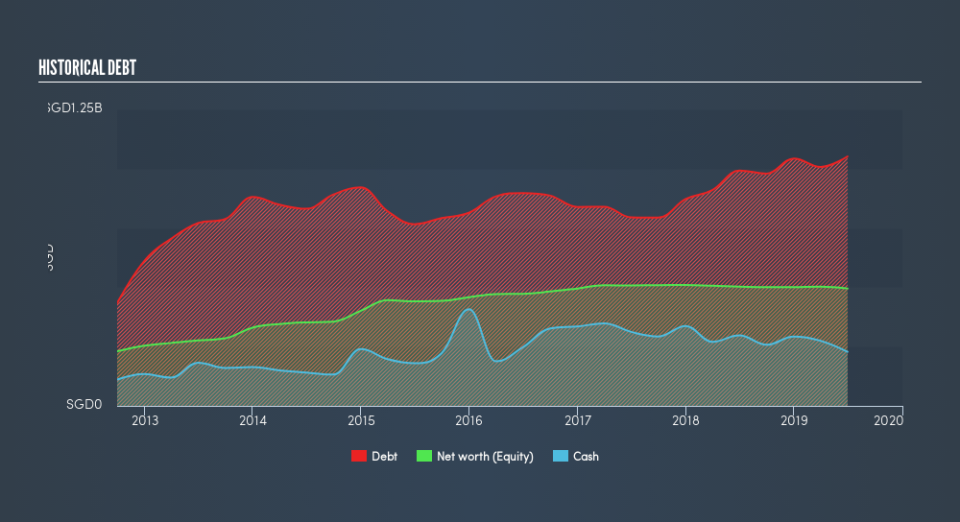Roxy-Pacific Holdings (SGX:E8Z) Seems To Be Using An Awful Lot Of Debt

David Iben put it well when he said, 'Volatility is not a risk we care about. What we care about is avoiding the permanent loss of capital.' So it seems the smart money knows that debt - which is usually involved in bankruptcies - is a very important factor, when you assess how risky a company is. Importantly, Roxy-Pacific Holdings Limited (SGX:E8Z) does carry debt. But the more important question is: how much risk is that debt creating?
When Is Debt A Problem?
Generally speaking, debt only becomes a real problem when a company can't easily pay it off, either by raising capital or with its own cash flow. Ultimately, if the company can't fulfill its legal obligations to repay debt, shareholders could walk away with nothing. However, a more usual (but still expensive) situation is where a company must dilute shareholders at a cheap share price simply to get debt under control. Having said that, the most common situation is where a company manages its debt reasonably well - and to its own advantage. When we examine debt levels, we first consider both cash and debt levels, together.
See our latest analysis for Roxy-Pacific Holdings
How Much Debt Does Roxy-Pacific Holdings Carry?
You can click the graphic below for the historical numbers, but it shows that as of June 2019 Roxy-Pacific Holdings had S$1.05b of debt, an increase on S$992.6m, over one year. On the flip side, it has S$228.0m in cash leading to net debt of about S$823.8m.
How Strong Is Roxy-Pacific Holdings's Balance Sheet?
According to the last reported balance sheet, Roxy-Pacific Holdings had liabilities of S$964.8m due within 12 months, and liabilities of S$262.5m due beyond 12 months. Offsetting this, it had S$228.0m in cash and S$78.3m in receivables that were due within 12 months. So its liabilities total S$921.0m more than the combination of its cash and short-term receivables.
This deficit casts a shadow over the S$508.6m company, like a colossus towering over mere mortals. So we definitely think shareholders need to watch this one closely. After all, Roxy-Pacific Holdings would likely require a major re-capitalisation if it had to pay its creditors today.
In order to size up a company's debt relative to its earnings, we calculate its net debt divided by its earnings before interest, tax, depreciation, and amortization (EBITDA) and its earnings before interest and tax (EBIT) divided by its interest expense (its interest cover). The advantage of this approach is that we take into account both the absolute quantum of debt (with net debt to EBITDA) and the actual interest expenses associated with that debt (with its interest cover ratio).
Roxy-Pacific Holdings shareholders face the double whammy of a high net debt to EBITDA ratio (28.9), and fairly weak interest coverage, since EBIT is just 1.3 times the interest expense. This means we'd consider it to have a heavy debt load. Notably, Roxy-Pacific Holdings's EBIT was pretty flat over the last year, which isn't ideal given the debt load. The balance sheet is clearly the area to focus on when you are analysing debt. But ultimately the future profitability of the business will decide if Roxy-Pacific Holdings can strengthen its balance sheet over time. So if you want to see what the professionals think, you might find this free report on analyst profit forecasts to be interesting.
Finally, while the tax-man may adore accounting profits, lenders only accept cold hard cash. So it's worth checking how much of that EBIT is backed by free cash flow. Over the last three years, Roxy-Pacific Holdings saw substantial negative free cash flow, in total. While that may be a result of expenditure for growth, it does make the debt far more risky.
Our View
To be frank both Roxy-Pacific Holdings's conversion of EBIT to free cash flow and its track record of staying on top of its total liabilities make us rather uncomfortable with its debt levels. But at least its EBIT growth rate is not so bad. Taking into account all the aforementioned factors, it looks like Roxy-Pacific Holdings has too much debt. That sort of riskiness is ok for some, but it certainly doesn't float our boat. Given our concerns about Roxy-Pacific Holdings's debt levels, it seems only prudent to check if insiders have been ditching the stock.
When all is said and done, sometimes its easier to focus on companies that don't even need debt. Readers can access a list of growth stocks with zero net debt 100% free, right now.
We aim to bring you long-term focused research analysis driven by fundamental data. Note that our analysis may not factor in the latest price-sensitive company announcements or qualitative material.
If you spot an error that warrants correction, please contact the editor at editorial-team@simplywallst.com. This article by Simply Wall St is general in nature. It does not constitute a recommendation to buy or sell any stock, and does not take account of your objectives, or your financial situation. Simply Wall St has no position in the stocks mentioned. Thank you for reading.

